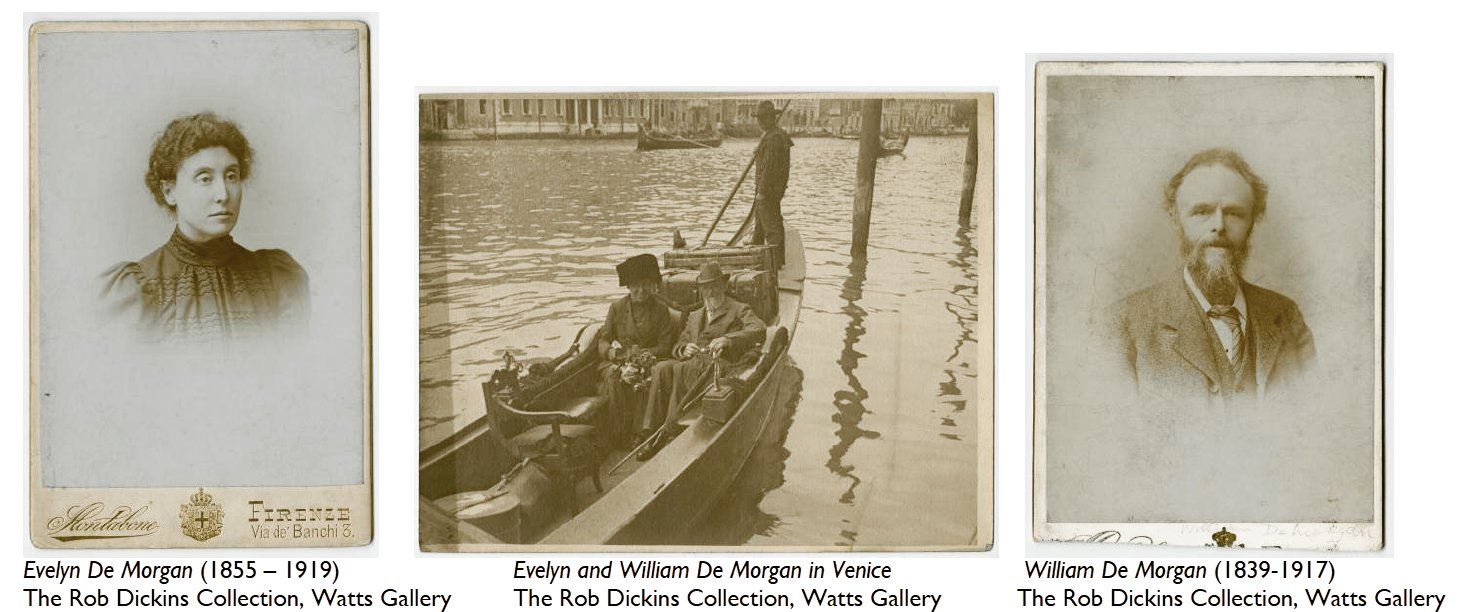

Left: Dragon Tile Panel by William De Morgan, 1872–1907. Collection: De Morgan Foundation. Right: Aurora Triumphans by Evelyn De Morgan, 1886. Collection:Russell-Cotes Art Gallery and Museum
“Two of the rarest spirits of the age.” Sir Edward Poynter, President of the Royal Academy
A pioneering couple from the Arts & Crafts movement, William and Evelyn De Morgan will be the focus of the winter exhibition at Watts Gallery (6 November 2012 – 27 January 2013). From glistening ceramics in vibrant Persian colours and metallic lustres by William De Morgan to the matt restraint of Evelyn De Morgan’s symbolic paintings, the exhibition will celebrate the achievements of this extraordinarily creative partnership.
Like G.F. and Mary Watts, William and Evelyn De Morgan were a married couple, one an esteemed designer and potter, the other a celebrated artist. Both couples knew each other and William De Morgan advised Mary on the building of a kiln in Compton for the firing of the sculpted terracotta for the Watts Chapel. They shared together an Arts and Crafts ethos tied with a strong interest in spirituality.

William De Morgan (1839 – 1917) was one of the greatest ceramicists of his age and his brilliant lustre-ware pots and decorative tiles are known to many. His rediscovery of lustre was a significant technical contribution to the decorative arts of the nineteenth century. Amongst the exquisite objects on display at Watts Gallery will be:
- Dragon Tile Panel (1872-1907), De Morgan Foundation
- Blackbird Bottle (1888-1907), De Morgan Foundation
- Ferocious Lion Dish (1888-1907), De Morgan Foundation
Similarly, Evelyn De Morgan (1855 – 1919) drew on art to create a new language for the expression of her spiritual views. Strong design executed with bold colours, her paintings owed much to the allegories and symbolic paintings of G.F. Watts, whom she admired. Watts felt a great sympathy for her work and wrote that “I look upon her as the first woman artist of the day — if not of all time”. The Watts Gallery exhibition will include:
- Aurora Triumphans (1877-86 or c.1886), Russell-Cotes Art Gallery and Museum
- Phosphorus and Hesperus (1881), De Morgan Foundation
- Ariadne in Naxos (1877), De Morgan Foundation
Visitors will also have the chance to see a cabinet painted by William de Morgan, believed to have been made by William Morris, and Evelyn’s artist’s palette and palette knife, the latter a gift from G.F. Watts.
Commenting, Watts Gallery’s Curator, Mark Bills, says: “The Victorian age can boast of a number of famous cultural figures who were husband and wife and the Wattses were not alone in having a marriage which was also a creative partnership. Here, we celebrate the incredible output of G.F. and Mary Watts’s great friends in the Arts & Crafts Movement, William and Evelyn De Morgan.”
“The De Morgans visited Limnerslease, the Wattses’ home in Compton. It was to William De Morgan that Mary Watts turned when she installed a kiln in the grounds of the house, to fire the terracotta panels made by villagers for the Watts Cemetery Chapel. As the Watts Gallery Trust looks to save the Watts Studios and house for the nation, this exhibition affirms the property’s incredible legacy.”
This exhibition continues Watts Gallery’s programme of nationally important jewel-like exhibitions featuring work by leading artists of the 19th Century.
For further information and the exhibition and Watts Gallery, please visit www.wattsgallery.org.uk.
Last modified February 18 September 2012